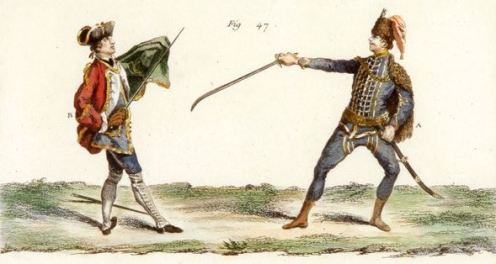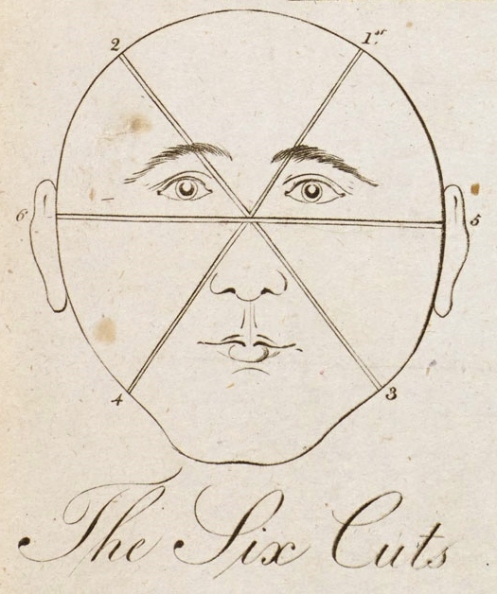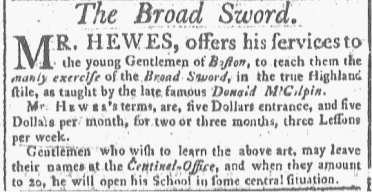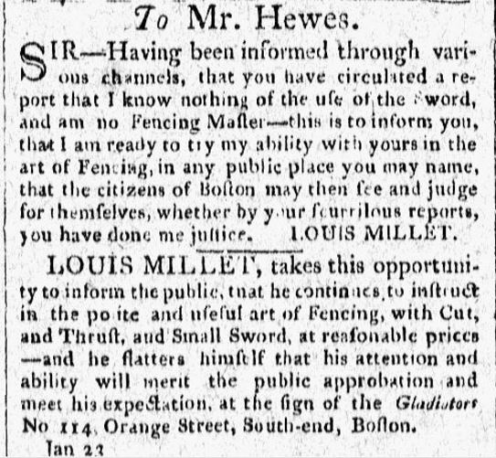An Early American Fencing Controversy: the Broadsword versus the Smallsword, in Boston, 1808
“Come, Mr. Millet, attack me in your turn, and do it well, or I shall catch you.” – Robert Hewes

Smallsword defense against Broadsword, from Angelo’s plates from L’Ecole des Armes included in “Escrime,” Encyclopédie (Paris, 1765).
Today, it is not uncommon to witness or overhear martial arts enthusiasts arguing over the merits of various weapons and respective martial arts methods, and their supposed superiority (or inferiority) over others.
Such a discussion, it turns out–in the form of a public controversy–also took place in early nineteenth century Boston, at a time when the world of American journalism was quickly expanding, making public arguments even more possible–and likely to occur–than ever before.
At the center of the incident was one Robert Hewes (1751-1830), a Boston native, local eccentric, and fencing master. Described by his contemporaries as an “extraordinary” and “ingenious” man, Hewes was a former member of the secret revolutionary society, the Sons of Liberty, and the first American fencing instructor that we know of to publicly advertise instruction in cane defense. He was described by the Boston press as a surgeon, as well as a “celebrated bone-setter and fencing master.” In acknowledgement of this fact, Hewes hung a sign outside his residence which humorously read, “Bone breaker and bone-setter.” According to Hewes himself, his training in fencing began about 1770, at which time he entered the school of the Scottish Highlander, Donald McAlpine.
Hewes was not the only fencing master in Boston at that time, as the city played host to numerous schools and academies–including several run by French immigrant fencing instructors. Animosity had evidently sprung up between Hewes and one of his French competitors, for, on January 23, 1808, the following announcement appeared in the pages of the Boston journal, the Columbian Centinel:
Evidently, Louis Millet had recently arrived in Boston, for very the same day he posted his challenge to Hewes, he also published (in the same issue) his first fencing advertisement in the city, informing the public that he offered instruction in the “polite and useful art of Fencing, with Cut, and Thrust, and Small Sword, at reasonable prices.” Millet was also associated with a group of French instructors, including Messrs. Tromelle and Girard, at the military fencing school of Colonel Amelot De La Croix, also in the Boston area (Independent Chronicle, March 20, 1809).
Only a few days later, on January 27, Hewes published a response in the Centinel, containing an account of a previous combat between himself and Millet. Hewes’ unusually detailed description, related with his characteristic humor, offers insight into the fencing method he was using, as well as a fascinating glimpse into the fencing world of post-Revolutionary Boston:
To Mr. Millet.
SIR—In last Saturday’s Centinel, you charge me with saying, that you know nothing of Fencing, &c—and invite me to a public trial of skill, &c—As to the scurrilous charge of my saying that you know nothing of the use of the Sword, I can in conscience deny it:—But, what I have said, and do now say, is this—That I believe you understand the Small Sword very well; but that you do not so well understand the Broad Sword;—so think some of your friends.
Mr. MILLET, you must give me leave to presume, that I do understand what the Broad Sword is scientifically; having learnt it of the famous DONALD Mc GILPIN, a Scotch Highlander, above thirty eight years ago; and I have had the honor and pleasure of teaching it to many of the Officers of our Revolutionary Army, in Roxbury and Cambridge, in the year 1775—and have done it at times, ever since. During the last ten years I have kept a regular school. But the Broad Sword you understand, is the French Counterpoint—a great difference.
The next thing is you invite me to a publick trial of skill.—With whom? A man I do not know. And for what? Why to please you, and a gaping multitude, that will know no more of the merits of it after it is over, than they did before it commenced.—What I, the hoary head, in boyish martial sports, on publick stage exposed! Oh, no no! Mr. MILLET; my rank in society, my age, forbid it; especially with a competitor I do not know. But why do you want another trial, when we have already had a fair one, by your own application and desire; and contrary to my wish; yet I desire to be thankful it was so public that I have sufficient evidence to full substantiate the merits of our combat.— A plain recital of the facts, attested by the evidence with a technical description of our combat, I will endeavor to relate in truth and dispassionately;—
About a month ago, you was introduced to me by your friend, Mr. ————. After being in the room a little while, you desired to play with me—I declined. There were two young gentlemen, my scholars, in the room—I pointed to the eldest of them, and said, “Play with him.”
“Yes,” said the young gentleman, “I will play with you.”
(MILLET.) “No,” said you, “if I play with any body here, I shall play with the master.”
“Then,” said I, “you’ll play with me, quick time.”
I then presented you with one broad sword Foil; I having the other myself. My two pupils paid strict attention to everything we did; but your friend, Mr. P———, seemed to be regardless of what was going on, for he sat all the time eating nuts as hearty as a grey squirrel.
Now comes the technical description of the combat:—First, we join issue upon an inside guard—I cut you with cut two, on the outside of your arm:—you then come to the counterpoint guard in seconde—I cut you four, under your arm;—we join again and I cut your leg with cut six;—the next was a counter.

An image showing the numbered cuts from the treatise of Col. Le Marchant, which was edited and republished by Hewes in America.
I then said, “Come, Mr. MILLET, attack me in your turn, and do it well, or I shall catch you.” You then made a little movement and hit my arm. You then came in a very swordsman like manner, and made cut five, at my body—I spring back, slipped your cut, and gave you a plump cut upon the head—and so the combat finished, by my cutting you four times, and you cutting me once.
Now, Mr. MILLET, since you have treated me in this scurrilous manner, by denying the merits of our combat, which was solicited by yourself, and persisting in publishing your scurrilous piece; I am determined never to have another trial of skill with you, publick or private; nor to have any altercation or conversation with you, written or verbal; and if any thing more shall appear in the papers, I am determined not to take the least notice of it.
ROBERT HEWES,
Jan 25, 1808.
[The two gentlemen scholars of Mr. H. have appeared at this office, and testified to the truth of Mr. H’s account of the combat, above referred to.]
More than a year later, on May 17, 1809, Hewes felt compelled to offer details of another similar incident, in the following nationalistic piece, published in the pages of the Centinel:
To Young Gentlemen who intend to learn the Art of Defence on foot with the Broad Sword and Sabre or Cut and Thrust.
IT always has been, and with some is still a disputed point which is best, the Broad Sword, or Small Sword.—Some will assert, (not knowing what the true Scotch Broad Sword is) that the Broad Sword is no manner of Defence against the Small Sword.—Others (who understand the Broad Sword well, and can play well, by daily experience) prove, that it is a complete Defence against the Small Sword, by evading or guarding their thrusts—and cutting their head or arm, which they generally do twice out of three:—the reason is, being too much practised in bending the elbow the Cuts of the Broad Sword meet their arm instantly;—as was verified the other day thus:—One of my Scholars introduced a French Gentleman and desired to play the Small Sword with him. We played loose pretty sharp a few moments, and neither hit.—He then desired us to play Cut and Thrust—we did;—but he no sooner moved than I cut his arm three times. He then says to my Scholar the reason Mr. HEWES cut my arm so easy is, because I am too much in the habit of playing the Small Sword with a crooked arm—therefore I cannot play Cut and Thrust. This Gentleman was candid enough to own, that the Cut and Thrust cannot be played with a crooked arm:—Therefore, to play true and with safety with a Cut and Thrust, the Broad Sword, according to the Scotch and Austrian systems, must be well learnt.—Which forbids the bending the elbow, raising or lowering the arm or passing the line to the right or left—in fine, the arms is as an iron bar, the wrist the pivot round which the Sabre flies, or in other words, the hand and hilt of the Sword is the centre of action, as a hob to a wheel; the blade as the spokes.
If there are any young Gentlemen Americans, who believe that a Prophet can have honor in his own country, and that it is not supernatural or notional to be master of an art, they may well have full satisfaction, as to the true system of the Broad Sword, uniting the Scotch and Austrian methods, which constitute the Cut and Thrust, by applying to their humble servant, ROBT HEWES,
Sign of the Gladiators, Ann Street, near the Draw Bridge, Boston—who has had the pleasure of teaching the Broad Sword near forty years.
VIVAT YANKEE DOODLE
N.B.—The Horse and Train of Artillery Sabre Exercise—and Cane Fighting taught as heretofore.
May 17.
Hewes’ French rivals were evidently furious, for the next day they published the following in the Centinel:
Take Particular NOTICE!
SOME Fencing Masters have read in the Columbian Centinel, the observations of a Mr. Robert Hewes, styled Primary Military School—setting forth the advantage of the Scotch Broad Sword—Experience having demonstrated to then, that the gentleman infallible to a mistake, without enlarging on the observations, which would demonstrate that even a slight wound on the arm would not prevent his antagonist from thrusting his sword through his body, and without remarking, that gentlemen in the habit of fencing with baskets, as it has been observed, would soon be disabled in the hand if armed with an ordinary Sabre—In order to prove in an undeniable manner, what they now assert—the Fencing Masters have the honor to invite Mr. Hewes, respectfully to attend the general assault—to be given on the 23d inst. at the Military School, Court-street, No. 17, where he may have his choice in any kind of fencing, or cane-fighting, on the true principles of the Paris Academy. They flatter themselves that Mr. Hewes will not fail to appear—his assertions render his presence indispensible, and the Spectators are entitled to a demonstration.
Boston, May 18.
Hewes, however, true to his word, neglected to take this “bait,” although he remained an ever-present voice, and teacher, in the Boston fencing world until his death in 1830.
POSTSCRIPT:
In the end, Hewes merely defended his method as a “complete defence” against other weapons such as the small-sword, and did not necessarily assert its superiority over them. By contrast, Donald McBane–a Scottish swordsman regarded as one of the most prolific duelists of all time–wrote in his treatise that the small-sword had “great odds” over the broadsword, and over nearly all other weapons. If anything, the outcome of Hewes’s combat with Millet (if we are to believe the former’s account), attests to the usefulness (and during the period, the necessity) of a swordsman being familiar with both (or all) predominant methods and weapons in use at the time. Indeed, in considering the entire history of fencing, it is evident that the ultimate superiority lies in the fencer who wields the sword, not in the particular type of weapon wielded.
As a treat for readers, we end with another lengthy, colorful, and humorous period fencing advertisement, courtesy of Robert Hewes:




